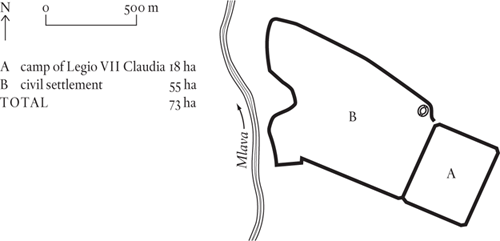
East of Kostolac, Serbia
Provincial capital of undivided Moesia, subsequently of Moesia Superior and, in the late Roman period, Moesia Prima
Viminacium is situated near the point where the Morava river (classical Margus) joins the Danube. This made it the linchpin of the L-shaped province of Moesia, which was charged with the defence of the right bank of the Danube between Belgrade and the Black Sea, together with the line of communication back to Macedon via the Morava–Vardar corridor. The position must have been held from the start of the Roman occupation of the area in 15 BC; the permanent camp was built in the 60s and 70s AD by Legio VII Claudia. The legion was to have Viminacium as its base for the better part of the next 400 years, a long posting by any standards.

The legionary fortress, of the usual playing-card shape, covers eighteen hectares, a little smaller than some. Attached to its west side is a civilian/veteran settlement covering fifty-five hectares, much larger than usual for such appendages. This settlement was recognized as an independent town (municipium) by the emperor Hadrian in 117, and as a Roman colony by Gordian III (238–44). Always the most important place in Moesia, it was the capital of the initial, undivided province, then, when the province was split in two, of Moesia Superior. When Diocletian divided the area into five it became the capital of Moesia Prima, and of the diocese of Dacia, a new collection of provinces of Diocletian’s invention.
Viminacium was destroyed by the Huns in 441 and never reoccupied. In the mid sixth century the name was revived for a fortress that the emperor Justinian built on the far side of the Mlava, a loop of the Danube that skirts the western edge of the original town. This fortress, which covered a mere six hectares, acted as the civil, military and ecclesiastical centre for the recovered province until all was swept away in the Slav invasions of the early seventh century. The modern town of Kostolac, whose name is sometimes used as a synonym for Viminacium, lies even further to the west; its name is a Bulgarization of castellum (‘castle’), and refers to Justinian’s fort, not the classical town.
The only certain datum we have regarding Viminacium’s population is the size of the garrison, which was in the order of 5,000 in AD 60–250 and 1,200 in AD 350–400. The population of the attached town would presumably have been comparable, which means that, at its best, the complex would have passed the magic 10,000 mark. Of course, that doesn’t mean that it qualifies as a permanent city of that size, because half the number would have consisted of soldiers, but it does mean that it ranks among the empire’s most prosperous garrison towns.